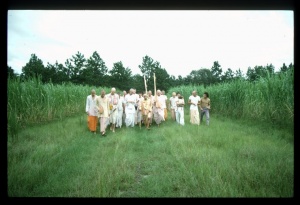CC Madhya 4.61 (1975): Difference between revisions
(Vanibot #0027: CCMirror - Mirror CC's 1996 edition to form a basis for 1975) |
(Vanibot #0020: VersionCompareLinker - added a link to the Version Compare feature) |
||
| Line 2: | Line 2: | ||
<div style="float:left">'''[[Sri Caitanya-caritamrta (1975)|Śrī Caitanya-caritāmṛta (1975)]] - [[CC Madhya (1975)|Madhya-līlā]] - [[CC Madhya 4 (1975)|Chapter 4: Śrī Mādhavendra Puri's Devotional Service]]'''</div> | <div style="float:left">'''[[Sri Caitanya-caritamrta (1975)|Śrī Caitanya-caritāmṛta (1975)]] - [[CC Madhya (1975)|Madhya-līlā]] - [[CC Madhya 4 (1975)|Chapter 4: Śrī Mādhavendra Puri's Devotional Service]]'''</div> | ||
<div style="float:right">[[File:Go-previous.png|link=CC Madhya 4.60 (1975)|Madhya-līlā 4.60]] '''[[CC Madhya 4.60 (1975)|Madhya-līlā 4.60]] - [[CC Madhya 4.62 (1975)|Madhya-līlā 4.62]]''' [[File:Go-next.png|link=CC Madhya 4.62 (1975)|Madhya-līlā 4.62]]</div> | <div style="float:right">[[File:Go-previous.png|link=CC Madhya 4.60 (1975)|Madhya-līlā 4.60]] '''[[CC Madhya 4.60 (1975)|Madhya-līlā 4.60]] - [[CC Madhya 4.62 (1975)|Madhya-līlā 4.62]]''' [[File:Go-next.png|link=CC Madhya 4.62 (1975)|Madhya-līlā 4.62]]</div> | ||
{{CompareVersions|CC|Madhya 4.61|CC 1975|CC 1996}} | |||
{{RandomImage}} | {{RandomImage}} | ||
==== TEXT 61 ==== | ==== TEXT 61 ==== | ||
| Line 32: | Line 31: | ||
<div class="purport"> | <div class="purport"> | ||
The ingredients of pañca-gavya are milk, yogurt, ghee (clarified butter), cow urine and cow dung. All these items come from the cow; therefore we can just imagine how important the cow is, since its urine and stool are required for bathing the Deity. The pañcāmṛta consists of five kinds of | The ingredients of pañca-gavya are milk, yogurt, ghee (clarified butter), cow urine and cow dung. All these items come from the cow; therefore we can just imagine how important the cow is, since its urine and stool are required for bathing the Deity. The pañcāmṛta consists of five kinds of nectar-yogurt, milk, ghee, honey and sugar. The major portion of this preparation also comes from the cow. To make it more palatable, sugar and honey are added. | ||
</div> | </div> | ||
Latest revision as of 17:52, 27 January 2020

A.C. Bhaktivedanta Swami Prabhupada
TEXT 61
- pañca-gavya, pañcāmṛte snāna karāñā
- mahā-snāna karāila śata ghaṭa diñā
SYNONYMS
pañca-gavya—in five kinds of products from the cow; pañca-amṛte—in a preparation made with five palatable foods; snāna—bath; karāñā—finishing; mahā-snāna—a vast bath with ghee and water; karāila—performed; śata—one hundred; ghaṭa—waterpots; diñā—with.
TRANSLATION
After the first bathing, further bathings were conducted with pañca-gavya and then with pañcāmṛta. Then the mahā-snāna was performed with ghee and water, which had been brought in one hundred pots.
PURPORT
The ingredients of pañca-gavya are milk, yogurt, ghee (clarified butter), cow urine and cow dung. All these items come from the cow; therefore we can just imagine how important the cow is, since its urine and stool are required for bathing the Deity. The pañcāmṛta consists of five kinds of nectar-yogurt, milk, ghee, honey and sugar. The major portion of this preparation also comes from the cow. To make it more palatable, sugar and honey are added.